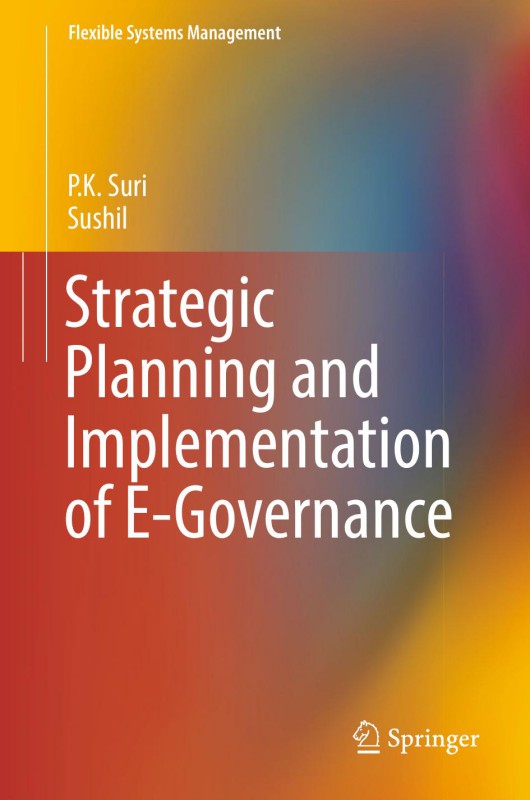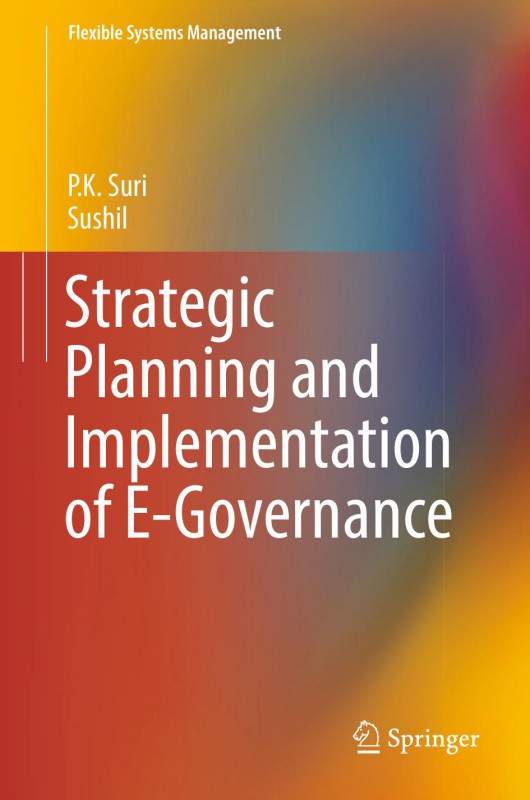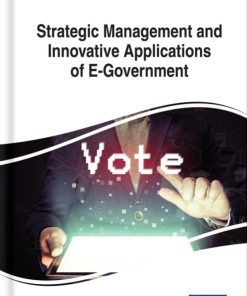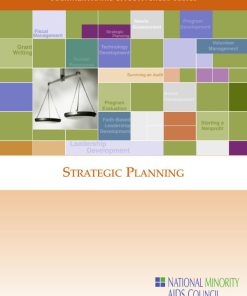Strategic Planning and Implementation of E Governance 1st Edition by Suri, Sushil 9811021759 9789811021756
$50.00 Original price was: $50.00.$25.00Current price is: $25.00.
Authors:P.K. Suri, Sushil (auth.) , Series:Strategic Studies [10] , Author sort:P.K. Suri, Sushil (auth.) , Languages:Languages:eng , Published:Published:Aug 2016 , Publisher:Springer
Strategic Planning and Implementation of E Governance 1st Edition by Suri, Sushil – Ebook PDF Instant Download/Delivery. 9811021759, 9789811021756
Full download Strategic Planning and Implementation of E Governance 1st Edition after payment

Product details:
ISBN 10: 9811021759
ISBN 13: 9789811021756
Author: P.K. Suri, Sushil
Strategic Planning and Implementation of E Governance 1st Table of contents:
1 Introduction to E-Governance
1.1 General Background
1.2 E-Governance in India
1.3 E-readiness Status of India
1.4 E-Governance in Agriculture––Significance and Challenges
1.4.1 Agriculture-Related Popular Grassroot ICT Projects in India
1.4.2 Agriculture-Related National/Multi-state E-Governance Projects in India
1.5 Significance of the Book
1.6 Concluding Remarks
References
2 Measuring E-Governance Performance
2.1 Introduction
2.2 Key Stakeholders and Value from E-Governance
2.3 Contributions of E-Governance
2.4 Assessment of E-Governance
2.5 Conceptualization of Performance Variables
2.5.1 Macro-variable
2.5.2 Micro-variables
2.6 Generalized Multi-perspective Performance Analysis
2.7 Concluding Remarks
References
3 A Strategic Framework for Improving E-Governance Performance
3.1 Introduction
3.2 Synthesized Recommended Framework
3.2.1 Changing Situation (Driver)
3.2.2 Strategic Planning (Enabler)
3.2.3 Strategy Implementation (Enabler)
3.2.4 Performance (Outcome)
3.3 Framework Implementation Considerations
3.3.1 Planning-Level Considerations
3.3.2 Implementation-Level Considerations
3.3.3 Beneficiaries-Level Considerations
3.4 Methodology for Developing Strategic Framework
3.4.1 Interpretation in Case Studies and Synthesis of Interpretations
3.5 Concluding Remarks
Reference
4 Changing Situation: A Driver of E-Governance
4.1 Introduction
4.2 Significance of Shared Vision and Mission
4.3 Access to Service
4.4 Changing User Needs
4.5 Feedback Loop
4.6 Reflections from Survey of Actors
4.6.1 Univariate Analysis and Regression Summary
4.6.1.1 Micro-variables of Effectiveness of Strategy Implementation
4.6.2 Multivariate Analysis
4.7 Concluding Remarks
References
5 Strategic Planning: An Enabler of E-Governance
5.1 Introduction
5.1.1 Extent of Planning
5.1.2 Comprehensiveness of Strategy Formulation
5.1.3 Flexibility of Processes
5.2 Suitability of Conventional Planning Approach to E-Governance Projects
5.3 Significance of Environmental Analysis in E-Governance
5.4 Planning for Service Delivery
5.5 Strategic Importance of Stakeholders in E-Governance
5.6 Strategic Importance of Collaborations in E-Governance
5.7 Need for Refining Structure and Processes
5.8 Significance of Feedback System
5.9 Reflections from Survey of Actors
5.9.1 Univariate Analysis and Regression Summary
5.9.1.1 Micro-variables of Extent of Planning
5.9.1.2 Micro-variables of Comprehensiveness of Strategy Formulation
5.9.1.3 Micro-variables of Flexibility of Processes
5.9.2 Multivariate Analysis
5.10 Concluding Remarks
References
6 Strategy Implementation: An Enabler of E-Governance
6.1 Introduction
6.1.1 Effectiveness of Strategy Implementation
6.1.2 Competence Level of Actors
6.2 Involvement of Senior Leadership
6.3 Motivation of Operational Staff
6.4 Empowerment of Operational Employees
6.5 Effective Communication
6.6 Competence of Actors
6.7 Involvement of Stakeholders in Implementation
6.8 Building Collaborative Relationships Through Strategic Alliances
6.9 Reflections from Survey of Actors
6.9.1 Univariate Analysis and Regression Summary
6.9.1.1 Micro-Variables of Effectiveness of Strategy Implementation
6.9.1.2 Micro-Variables of Competence Level of Actors
6.9.2 Multivariate Analysis
6.10 Concluding Remarks
References
7 Case Studies of Agriculture Related G to C and G to E Projects
7.1 Introduction
7.2 Methodology for the Case Studies
7.3 Case Study 1: AGMARKNET
7.3.1 Brief Description of the Project
7.3.2 S-A-P Analysis
7.3.2.1 Situation Analysis
7.3.2.2 Summary of Key Developments in the Post-Study Period
7.3.3 Observations from Opinion Surveys and L-A-P Synthesis
7.4 Case Study 2: Kisan Call Centre
7.4.1 Brief Description of the Project
7.4.2 S-A-P Analysis
7.4.2.1 Situation Analysis
7.4.2.2 Summary of Key Developments in the Post-Study Period
7.4.3 Observations from Opinion Surveys and L-A-P Synthesis
7.5 Case Study 3: DACNET
7.5.1 Brief Description of the Project
7.5.2 S-A-P Analysis
7.5.2.1 Situation Analysis
7.5.2.2 Key Actors and their Responsibilities
7.5.2.3 Actor-Process Linkages
7.5.2.4 Summary of Key Developments in the Post-Study Period
7.5.3 Observations from Opinion Surveys and L-A-P Synthesis
7.6 Concluding Remarks
References
8 Case Studies of Agriculture Related G to B Projects
8.1 Introduction
8.2 Case Study 4: Grapenet
8.2.1 Brief Description of the Project
8.2.2 S-A-P Analysis
8.2.2.1 Situation Analysis
8.2.2.2 Actor—Process Linkages
8.2.2.3 Value Accrued from Grapenet
8.2.3 Observations from Opinion Surveys and L-A-P Synthesis
8.3 Case Study 5: Computerized Registration of Pesticides (CROP)
8.3.1 Brief Description of the Project
8.3.2 S-A-P Analysis
8.3.2.1 Situation Analysis
8.3.2.2 Actor—Process Linkages
8.3.2.3 Summary of Key Developments in the Post-study Period
8.3.3 Observations from Opinion Surveys and L-A-P Synthesis
8.4 Case Study 6: Integrated Fertilizers Management Information System
8.4.1 Brief Description of the Project
8.4.1.1 Fertilizers Information Linkages of the DoF
8.4.2 S-A-P Analysis
8.4.2.1 Situation Analysis
8.4.2.2 Actor–Process Linkages
8.4.2.3 Summary of Key Developments in the Post Study Period
8.4.3 Observations from Opinion Surveys and L-A-P Synthesis
8.5 Concluding Remarks
References
9 Effective E-Governance Through Strategic Alliances—An Illustration
9.1 Introduction
9.2 Central Organizations and Their Agricultural Marketing-Related Information Systems
9.2.1 Agricultural Market Information System of DMI
9.2.2 Market Information System of DES
9.2.3 Market Information System of NHB
9.2.4 Market Information System of DCA
9.3 Case Analysis Based on SAP–LAP Framework
9.3.1 Learning Issues
9.3.1.1 Redundant Efforts and Lack of Synergy
9.3.1.2 Inherent Gaps in Each System
9.3.1.3 Farmer Centricity
9.3.1.4 Need for Sharable Repositories
9.4 Developing Market Information Service by Forming an Inter-organizational Strategic Alliance
9.4.1 Role of DMI, DES, NHB and DCA in the Proposed Alliance
9.4.1.1 Directorate of Marketing and Inspection (DMI)
9.4.1.2 Directorate of Economics and Statistics (DES)
9.4.1.3 National Horticulture Board (NHB) and Department of Consumer Affairs (DCA)
9.4.1.4 Expected Value Creation Through Inter-organizational Alliance
9.4.1.5 Likely Conflicts in Alliance Formation
9.4.1.6 A Few Guidelines for Overcoming the Challenges
9.5 Concluding Remarks
References
10 Effective E-Governance: The Way Forward
10.1 Introduction
10.2 Strategic Recommendations
10.2.1 Systems Approach to Plan for E-Governance Project
10.2.2 Strengthening Bottom-up Planning Through Emergent Strategy and Village Level Socio-economic D
10.2.3 Designing Flexible Planning Processes
10.2.4 Rejuvenating IT Units of Government Departments
10.2.5 Accelerating Organizational Learning and Responsiveness
10.2.6 Practicing Contact Leadership
10.2.7 Monitoring Strategic Effectiveness Based on Governance Reforms
10.2.8 Improving Service Levels Through Learning Loops
10.2.9 Forming Strategic Alliances for Effective E-Governance
10.2.10 Ensuring Strategic Coherence Among Planners and Implementers
10.2.11 Bridging Planners–Beneficiaries Gaps
10.2.12 Shared Ownership of E-Governance Services
10.2.13 Incentivizing Implementers for Local Initiatives
10.2.14 Ensuring Adoption of E-Governance Services
10.2.15 Enabling Implementers and Beneficiaries for Participatory Governance and Demand-Driven Servi
10.2.16 Strengthening the National Informatics Centre
10.3 Concluding Remarks
References
Appendix A
Appendix B
Appendix C
Appendix D
Appendix E
Appendix F
Appendix G
People also search for Strategic Planning and Implementation of E Governance 1st:
strategic planning and governance
strategic planning and implementation of e-governance
strategic governance
strategic planning development and implementation process
You may also like…
eBook PDF
Strategic Management for Public Governance in Europe 1st Edition by Anne Drumaux, Paul Joyce












